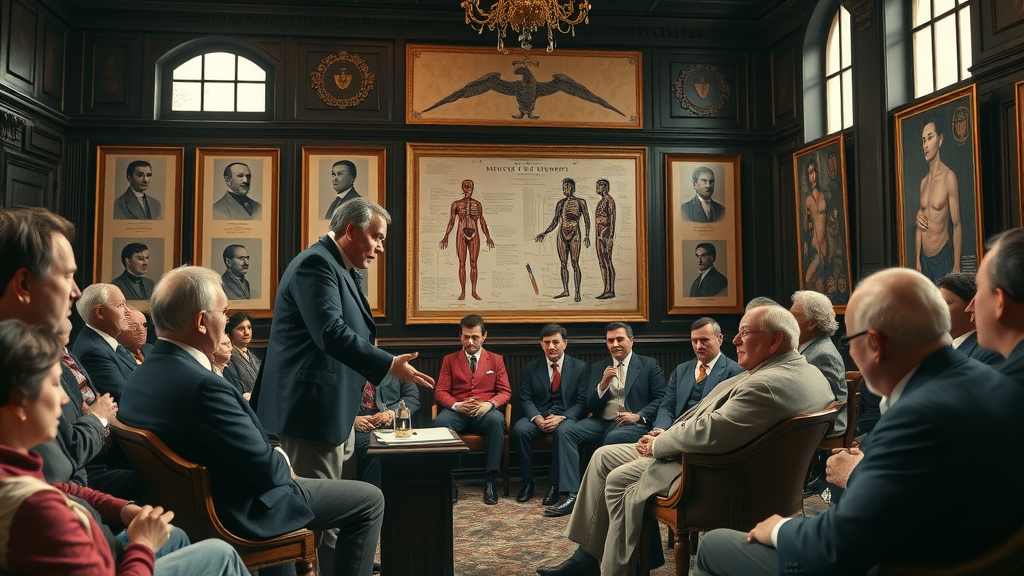Did you know that nearly 15% of the population is highly susceptible to hypnosis? Despite this intriguing statistic, the roots and evolution of hypnosis are often misunderstood or shrouded in mystery. From ancient temple rituals to cutting-edge therapy for mental health, the history of hypnosis is packed with captivating stories, influential figures, and dramatic turning points. In this comprehensive guide, you’ll uncover the story of hypnosis, explore how it moved from mystical ceremonies to respected medical techniques, and meet the people who shaped clinical hypnosis into what it is today.
Unearthing the History of Hypnosis: A Statistic That Might Surprise You
A Startling Fact about the History of Hypnosis
"Nearly 15% of the population is highly susceptible to hypnosis—yet the story of hypnosis dates back thousands of years."
When we think about the history of hypnosis, it’s fascinating to consider just how many people are naturally inclined to experience a hypnotic state. This level of susceptibility has profound implications, explaining why hypnosis has persisted in varying forms across eras, cultures, and scientific paradigms. The journey begins with spiritual practices in ancient civilizations, where trance and altered state rituals played crucial roles in healing and religious ceremonies. Over time, the process shifted, influenced by figures such as franz anton mesmer and james braid, who helped formalize concepts such as animal magnetism and later, scientific hypnosis.
Today, hypnosis is no longer viewed as mysterious magic or mere superstition. Advanced research by medical associations and clinical trials have thrust hypnosis into the spotlight as a legitimate tool for mental health, pain management, and the treatment of psychological disorders. This enduring story of hypnosis is proof that our understanding of the conscious and unconscious mind continues to evolve—shaped by both ancient wisdom and contemporary science.

What You'll Learn About the History of Hypnosis
How spiritual practices shaped the history of hypnosis
The origins of animal magnetism with Franz Anton Mesmer
Key contributors: James Braid, Martin Charcot, Sigmund Freud, Milton Erickson
How modern hypnotherapy evolved from ancient techniques
Controversies, milestones, and scientific discoveries
Tracing the Story of Hypnosis Through the Ages
Early Spiritual Practices and Hypnotic States
Hypnotic state rituals in ancient Egypt and Greece
Spiritual practices in indigenous cultures
The role of trance in religious ceremonies
"Priests and healers used hypnotic states long before scientific study began—shaping the early history of hypnosis."
The foundations of the history of hypnosis can be traced to the earliest human civilizations. In ancient Egypt, priests would guide individuals into a trance state in healing temples, using repetitive chants and mesmerizing rituals to induce altered states of consciousness. These spiritual practices were also mirrored in ancient Greece, where “sleep temples” offered therapeutic rest, dream interpretation, and trance as a pathway to recovery, predating any formal medical understanding of hypnosis.
Indigenous cultures worldwide have long employed hypnotic or trance states in their sacred rites. Shamans, spiritual healers, and religious leaders harnessed the power of focused attention and suggestion to promote healing, evoke visions, and connect with the unconscious mind. Often, these rituals involved rhythmic music, persistent drumming, or controlled breathing—all precursors to the formal hypnosis techniques developed centuries later. Through these spiritual acts, the concept of entering a hypnotic state for personal growth, healing, or enlightenment has endured and evolved, reverberating throughout the subsequent story of hypnosis.

For readers interested in a more detailed timeline and analysis of pivotal moments, this historical review of hypnosis offers a focused look at the key events and figures that have shaped the discipline from its origins to the present day.
Animal Magnetism and Franz Anton Mesmer’s Influence on the History of Hypnosis
The Rise of Animal Magnetism
Franz Anton Mesmer and the theory of animal magnetism
Anton Mesmer’s controversial therapies
Public and scientific reactions to mesmerism
"Mesmer believed animal magnetism flowed through all living things—a legacy that still echoes in hypnosis discourse today."
In the late 18th century, German physician franz anton mesmer propelled the story of hypnosis onto the European stage. He theorized that an invisible force, which he called animal magnetism, could be manipulated to restore health by rebalancing a person’s energy flow. During dramatic public “magnetizing” sessions, anton mesmer would guide patients into deep, trance-like states by passing his hands over their bodies, employing tools such as rods and magnets, and orchestrating rituals that resembled both scientific inquiry and spiritual ceremony.
Although critics in the scientific community dismissed the concept of animal magnetism as unproven and even fraudulent, mesmerism became widely popular among the public. Controversy swirled around whether the phenomenon was genuine or simply psychological suggestion. Regardless, Mesmer’s influence endured, inspiring subsequent research into altered states and laying a crucial foundation for the future medical exploration of hypnosis. The language of mesmerism and the rituals he popularized are still echoed in the field of modern hypnosis today, linking his name forever to the history of hypnosis.

Scientific Shifts: James Braid and the Birth of Modern Hypnosis
How James Braid Coined ‘Hypnosis’ and Changed Its Story
James Braid's observations of hypnotic states
Distinguishing hypnosis from animal magnetism
Establishment of hypnosis as a medical technique
The 19th century marked a pivotal transformation in the history of hypnosis with the arrival of james braid, a Scottish surgeon with an analytical mind. Observing the apparent trance states produced during mesmerist demonstrations, Braid suspected a psychological explanation rather than a mystical energy. He coined the term “hypnosis”—inspired by the Greek word for sleep—and began systematically studying this altered state, emphasizing that focused attention and suggestion, rather than magnetic fluids, were responsible for the trance phenomenon.
Unlike mesmer, Braid advanced the idea that hypnosis was a form of concentrated mental focus, a state of heightened suggestibility distinct from both sleep and wakefulness. He outlined structured hypnosis techniques, introduced self-hypnosis practices, and advocated for its use as a legitimate medical and dental tool, especially for pain relief. By the end of his career, he rejected some of his own terminology but left behind a new legacy: a scientifically grounded, clinically relevant framework for hypnosis that inspired later researchers and medical associations to explore its therapeutic potential even further.

Contributions of Martin Charcot, Hippolyte Bernheim, and the Medicalization of Hypnotic Practice
Charcot, Bernheim, and the Battle for Hypnosis’ Scientific Validity
Martin Charcot’s neurological studies using hypnosis
Hippolyte Bernheim and the Nancy School
Hypnosis in treating psychological disorders
"Both Charcot and Bernheim advanced the history of hypnosis by exploring its therapeutic scope—from hysteria to suggestion therapy."
As the story of hypnosis entered the late 19th century, it became the battleground for two intellectual giants: martin charcot of the Parisian Salpêtrière Hospital and hippolyte bernheim of the Nancy School. Charcot, a neurologist, investigated hypnosis through the lens of neurological disorders, particularly hysteria. He demonstrated how certain patients could enter a hypnotic state under clinical observation and saw hypnosis as a valid tool for uncovering the complexities of the mind-body connection.
Meanwhile, hippolyte bernheim argued that suggestibility—not pathology—was the key to hypnosis. Through his research and clinical practice, Bernheim claimed that virtually anyone could benefit from suggestion therapy within a hypnotic state. This debate between the pathological and therapeutic models of hypnosis broadened its application and led to the adoption of hypnosis in the treatment of psychological disorders, further cementing its place in medical and psychological practice. Both Charcot and Bernheim helped bridge the gap between spiritual practices and scientific medicine, responsibly carrying the history of hypnosis into the realm of clinical psychology and psychiatry.

Sigmund Freud, Milton Erickson, and Hypnosis in Modern Psychology
How Freud’s and Erickson’s Approaches Shaped Modern Hypnotherapy
Sigmund Freud’s early experimentation with hypnosis
The transition to psychoanalysis and talk therapy
Milton Erickson’s innovative hypnotic techniques and their influence
Sigmund Freud, the father of psychoanalysis, initially experimented with hypnosis in his quest to access the unconscious mind. He believed that the hypnotic state allowed for the direct exploration of repressed thoughts, trauma, and desires. However, Freud eventually moved away from hypnosis, developing free association and other psychoanalytic techniques, but not before cementing the close relationship between hypnosis and modern psychotherapy. His work laid the groundwork for using suggestion and trance to facilitate healing and personal insight within therapy.
Later, milton erickson revolutionized the field with his innovative, indirect approach to clinical hypnosis. Instead of formal induction or direct suggestion, Ericksonian hypnosis emphasized language patterns, storytelling, and the patient’s own unique perception. Erickson demonstrated that hypnosis could be highly individual, adaptive, and deeply therapeutic—perfectly suited for a wide range of mental health concerns, from anxiety to trauma. Through his clinical insight, hypnosis secured its place within mainstream psychology and inspired generations of therapists and researchers to explore its potential for mental wellness and human transformation.

From Ancient Healing to Contemporary Therapy: The Continued Evolution in the History of Hypnosis
Major Milestones in Modern Hypnotherapy
British and American Medical Associations acknowledge hypnosis
Growth of clinical applications in pain, trauma, and addiction therapy
Modern misconceptions and scientific research
The journey from spiritual ritual to therapeutic science found its modern capstone when the British Medical Association and the American Medical Association officially recognized hypnosis as a legitimate adjunct therapy. Since then, hypnosis has become widely accepted in treating pain, supporting mental health, and managing trauma and addiction. Recent scientific research has dispelled many myths, confirming the brain-based mechanisms underlying the hypnotic state and showing how clinical hypnosis can facilitate deep transformation, focused attention, and behavior change.
Despite progress, misconceptions linger about hypnosis—fuelled by popular entertainment and misunderstandings of what hypnosis can and cannot do. Ongoing research and growing clinical expertise are gradually changing public perception, making it clear that the history of hypnosis is still being written in modern mental health clinics, hospitals, and research labs worldwide.

Table: Timeline of Key Events in the History of Hypnosis
Era |
Major Event/Person |
Impact |
|---|---|---|
Ancient Times |
Spiritual Practices |
Early trance and hypnotic rituals |
18th Century |
Franz Anton Mesmer/Animal Magnetism |
Introduction of mesmerism to Europe |
19th Century |
James Braid/naming of hypnosis |
Definition of hypnosis as medical practice |
Late 19th Century |
Charcot/Bernheim |
Hypnosis gains acceptance in neurology/psychology |
Early 20th Century |
Sigmund Freud |
Psychoanalytic study and use of hypnosis |
Mid-20th Century |
Milton Erickson |
Development of Ericksonian hypnosis techniques |
20th-21st Century |
Scientific and clinical expansion |
Hypnosis as therapy for pain, anxiety, and more |
Animated timeline progressing from ancient temples and Mesmer’s salons to modern therapy offices, overlaying illustrations of practitioners and evolving environments, supported by smooth crossfades, subtle background music, and engaging visual storytelling to highlight key milestones.
Lists: Influential Figures in the History of Hypnosis
Franz Anton Mesmer
James Braid
Martin Charcot
Hippolyte Bernheim
Sigmund Freud
Milton Erickson

People Also Ask About the History of Hypnosis
Who first discovered hypnosis?
"Franz Anton Mesmer is widely credited with discovering modern hypnosis, introducing animal magnetism in the late 18th century."
The question of who first discovered hypnosis doesn’t have a simple answer, given the use of hypnotic states in ancient spiritual practices. However, most historians attribute the formal discovery of modern hypnosis to franz anton mesmer, who introduced the concept of animal magnetism in the 18th century. While mesmer’s theories were eventually discredited, his methods sparked scientific and medical exploration into the hypnotic state, which influenced all later research and clinical practice. Today, mesmer’s name is synonymous with this revolutionary chapter in the story of hypnosis.
What does God say about hypnosis?
"Religious interpretations of hypnosis have varied, with some faiths accepting it as a spiritual practice, while others caution against its use."
The spiritual context of hypnosis is vast, with references to trance states found in many ancient religions. Some faiths, particularly in Eastern spiritual practices, embrace hypnosis as a tool for meditation, healing, and connecting with the divine. Other religious groups, however, remain cautious, warning adherents about surrendering personal will during hypnosis. Ultimately, views on hypnosis depend on doctrine, context, and cultural tradition, and the subject is still debated among theologians and spiritual leaders worldwide.
How was hypnotherapy used historically?
"Hypnotherapy has historically served purposes from spiritual healing to pain relief and the treatment of psychosomatic disorders."
Historically, hypnotherapy played an essential role in a range of healing traditions. In ancient times, trance states facilitated spiritual guidance, inner healing, and community rituals. With figures like anton mesmer, hypnosis was used to treat physical ailments and invisible maladies. Over time, its application shifted; by the 19th and 20th centuries, hypnosis was widely used for surgical anesthesia, relief from pain, and addressing psychological disorders. Today, modern clinical hypnosis builds on these roots, offering a structured, research-backed approach to a variety of mental and physical health challenges.
Who is the father of hypnosis?
"James Braid, a Scottish surgeon, is often regarded as the father of modern hypnosis for formalizing its scientific study."
While many contributed to hypnosis through history, james braid is widely considered the father of modern hypnosis. As a Scottish surgeon, he conducted detailed scientific analyses, challenging prior theories of animal magnetism and establishing hypnosis as a psychological phenomenon. Braid’s clear definitions, experimental approach, and advocacy for medical application of hypnosis laid the groundwork for the clinical hypnosis practices relied on by professionals today.
FAQs on the History of Hypnosis
Is hypnosis scientifically proven?
Yes. Numerous clinical studies have demonstrated the effectiveness of hypnosis in pain management, anxiety reduction, and the treatment of certain psychological disorders. The UK’s British Medical Association, American Medical Association, and the American Psychological Association all acknowledge the legitimacy of clinical hypnosis when used by trained professionals.Can hypnosis treat medical conditions?
Hypnosis has been successfully used to support medical treatment for chronic pain, irritable bowel syndrome, anxiety, trauma, and some forms of addiction. However, it should be seen as a complementary approach rather than a standalone cure and always practiced by certified professionals.How is hypnosis different from meditation?
Both practices involve focused attention and altered states of consciousness. However, hypnosis employs structured suggestion to achieve therapeutic goals, while meditation stresses self-awareness, relaxation, and mental clarity without direct suggestion or external guidance. Both can offer valuable mental health benefits, depending on your goals.
Key Takeaways: Understanding the History of Hypnosis
The history of hypnosis spans spiritual, scientific, and therapeutic domains
Influential figures like Franz Anton Mesmer and Sigmund Freud shaped modern practices
Modern hypnotherapy combines traditional and innovative techniques for mental well-being
Looking Forward: The Future of Hypnosis and Modern Therapy

The future of hypnosis is bright: as science continues to unravel the mysteries of the brain and consciousness, hypnosis is poised to become even more integrated into holistic mental health, therapy, and wellness practices worldwide.
Explore Professional Hypnotherapy Resources to Learn More About the History of Hypnosis
Ready to deepen your understanding of the history of hypnosis? Explore research articles, attend seminars, or connect with certified clinical hypnosis practitioners to unlock further insight into this fascinating, ever-evolving field.
If you’re curious about the broader context and foundational principles that underpin hypnosis, consider exploring what hypnosis truly is and how it works. This resource delves into the essential concepts, dispels common myths, and provides a strategic overview for anyone seeking a deeper grasp of hypnosis beyond its historical roots. By expanding your knowledge of both the history and the core mechanisms of hypnosis, you’ll be better equipped to appreciate its transformative potential in modern therapy and personal development.
 Add Row
Add Row  Add
Add 




Write A Comment